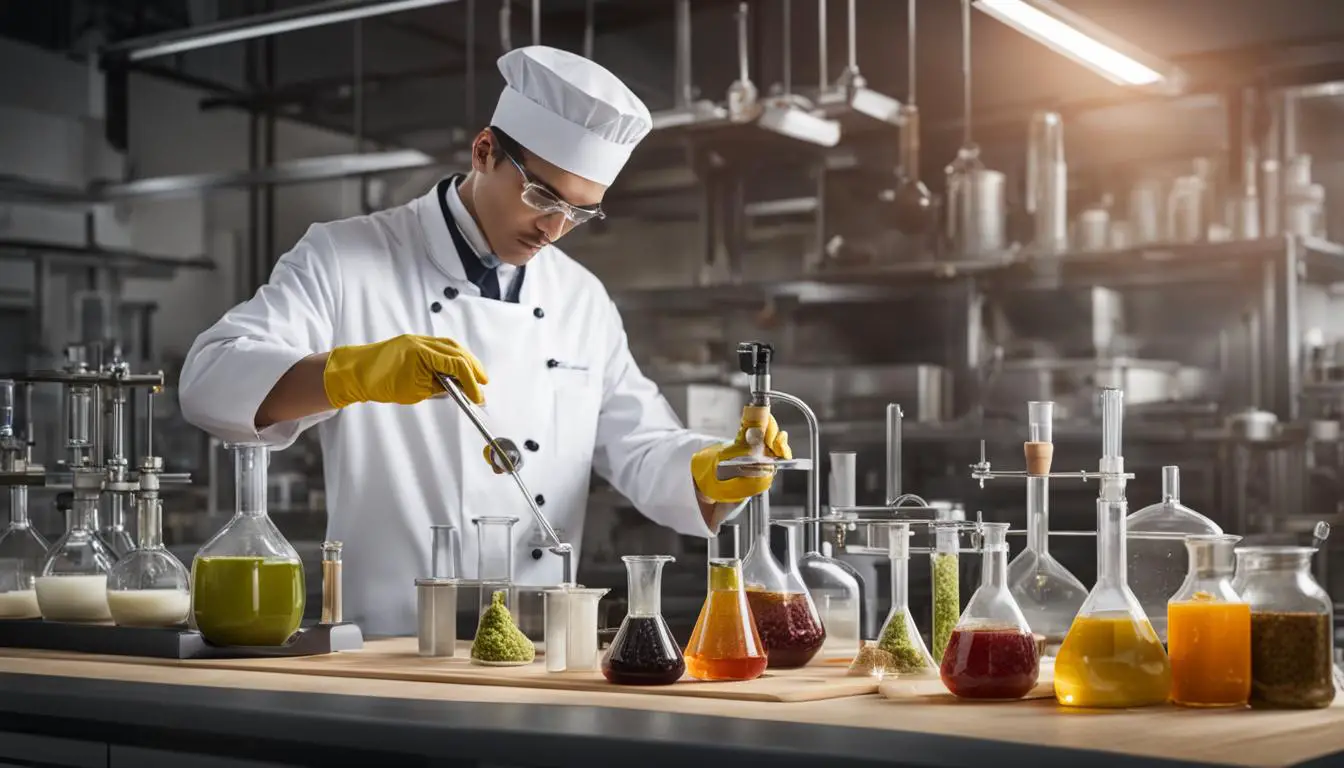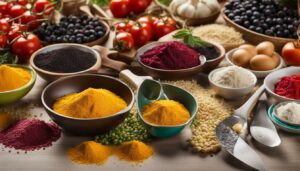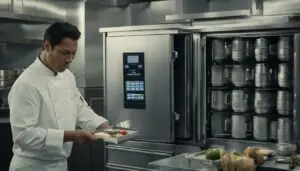If you’re a culinary innovator with a secret recipe that you want to protect, you may be wondering about the cost to patent a recipe. Patenting a recipe involves a complex and detailed process, and understanding the associated costs is crucial before proceeding.
While the cost to patent a recipe can vary depending on several factors, it’s important to budget accordingly to cover all expenses. In most cases, you should anticipate budgeting between $15,000 and $20,000 to complete the patenting process for your recipe. This includes the cost of drafting the application, government filing fees, and any additional expenses that may arise during the process.
Working with a patent attorney is highly recommended when patenting a recipe. Their expertise in intellectual property law can help navigate the complex legal process and increase the likelihood of a successful application. Let’s dive deeper into the patent process and explore the factors that contribute to the overall cost of patenting a recipe.
Contents
- 1 Understanding the Patent Process
- 2 Building a Prototype
- 3 Researching the Current Market
- 4 Hiring a Patent Attorney
- 5 Conducting a Prior Art Search
- 6 Identifying the Rightful Owner
- 7 Making a Patent Application
- 8 Notice of Allowance
- 9 Conclusion
- 10 FAQ
- 10.1 How much does it cost to patent a recipe?
- 10.2 What are the steps to patent a recipe?
- 10.3 Do I need to build a prototype before patenting a recipe?
- 10.4 Why is market research important when patenting a recipe?
- 10.5 Should I hire a patent attorney to patent a recipe?
- 10.6 Why is a prior art search necessary before patenting a recipe?
- 10.7 How do I identify the rightful owner of a recipe invention?
- 10.8 How do I make a patent application for a recipe?
- 10.9 What is a Notice of Allowance?
- 10.10 Any final thoughts on patenting a recipe?
- 11 Source Links
Key Takeaways:
- The cost to patent a recipe can range between $15,000 and $20,000.
- Hiring a patent attorney is highly recommended for expert guidance.
- Government filing fees and additional expenses should be considered in your budget.
- Thoroughly understanding the patent process is crucial before proceeding.
- Building a prototype and conducting market research are important steps in the process.
Understanding the Patent Process
The process to patent a recipe involves several steps. First, it is important to determine if your recipe meets the requirements for a United States patent. The recipe must be considered novel, meaning it has never been made or used before. It must also be useful and not considered obvious. Once these requirements are met, you can proceed with building a prototype, researching the current market, hiring a patent attorney, conducting a prior art search, identifying the rightful owner, making a patent application, and awaiting the notice of allowance.
Building a Prototype
Before patenting a recipe, it is essential to create a prototype of the food product. This step allows you to have a tangible and testable version of your recipe. By building a prototype, you can thoroughly assess the taste, texture, and overall quality of your culinary creation.
Creating a recipe prototype involves following the recipe instructions and measuring the ingredients precisely. It is crucial to replicate the recipe as accurately as possible to ensure that the prototype reflects your intended final product. This provides an opportunity to identify any necessary adjustments or improvements.
Once the prototype is ready, conduct taste tests and gather feedback from trusted individuals. This feedback is invaluable for refining your recipe and ensuring that it meets your desired standards. Consider experimenting with variations of the prototype to explore different flavors, textures, or presentation styles.
“Building a recipe prototype is a crucial step in the recipe development process. It allows you to perfect your recipe and make necessary adjustments before proceeding with the patenting process.”
Furthermore, documenting your prototype development journey can benefit the patenting process. Take detailed notes throughout the testing and refinement phases, including any modifications made and the rationale behind them. These records will provide valuable evidence of your recipe’s uniqueness and development process when submitting the patent application.
Remember that a well-developed and thoroughly tested prototype not only strengthens your patent application but also increases the chances of success in the marketplace. With a refined recipe that has proven to be appealing and delicious, you can confidently move forward with the patenting process and protect your culinary invention.
Recipe Prototype Checklist:
- Create a prototype that accurately reflects your desired final product
- Measure ingredients carefully to ensure consistency
- Conduct taste tests and gather feedback
- Consider variations or modifications to improve the recipe
- Document the prototype development journey
Researching the Current Market

When considering patenting a recipe, conducting thorough market research is essential to assess the viability and potential profitability of your culinary creation. By understanding the current market landscape and the demand for similar food products, you can make informed decisions about moving forward with the patenting process.
Market research for a recipe patent involves a comprehensive analysis of the competition, target demographic, and consumer trends. By examining existing food products in the market, you can identify potential competitors and evaluate their strengths and weaknesses.
Assessing recipe market viability requires studying consumer preferences and behavior. This involves understanding the target audience, their needs, and how your patented recipe aligns with their desires. By gathering insights into consumer trends and preferences, you can refine your recipe to better meet market demands.
Conducting thorough market research is an essential step in patenting a recipe. It provides valuable insights into the competitive landscape and helps you determine the potential profitability of your culinary invention.
Additionally, market research allows you to identify any gaps or untapped opportunities in the recipe market. This information can help you position your patent in a unique way, highlighting its distinct features and benefits that differentiate it from existing products.
Assessing Recipe Market Viability
Assessing the market viability of your patented recipe involves evaluating factors such as consumer demand, market trends, and potential sales volume. By analyzing these aspects, you can gauge the commercial potential and profitability of your recipe invention.
- Evaluate consumer demand: Determine the demand for similar food products in the market. Identify any current trends or preferences among consumers that align with your patented recipe.
- Understand target demographic: Analyze the target audience for your recipe and learn about their preferences, dietary restrictions, and buying habits. This information will help you tailor your recipe to meet their specific needs.
- Assess competition: Conduct a thorough analysis of existing food products that are similar to your patented recipe. Identify their market presence, pricing strategies, and the unique value propositions they offer. This knowledge will allow you to position your recipe in a way that differentiates it from competitors.
- Estimate sales potential: Determine the potential sales volume of your patented recipe by considering factors such as market size, consumer demand, and pricing. This will help you understand the financial viability and profitability of your recipe invention.
By researching the current market and assessing recipe market viability, you can make informed decisions about patenting a recipe that has the potential to generate profit and meet consumer demands.
Market research plays a crucial role in the recipe patenting process, providing valuable insights into consumer preferences, competition, and market trends. By conducting thorough research, you can increase the chances of successfully patenting a recipe that not only meets market demands but also has the potential for profitability.
Hiring a Patent Attorney
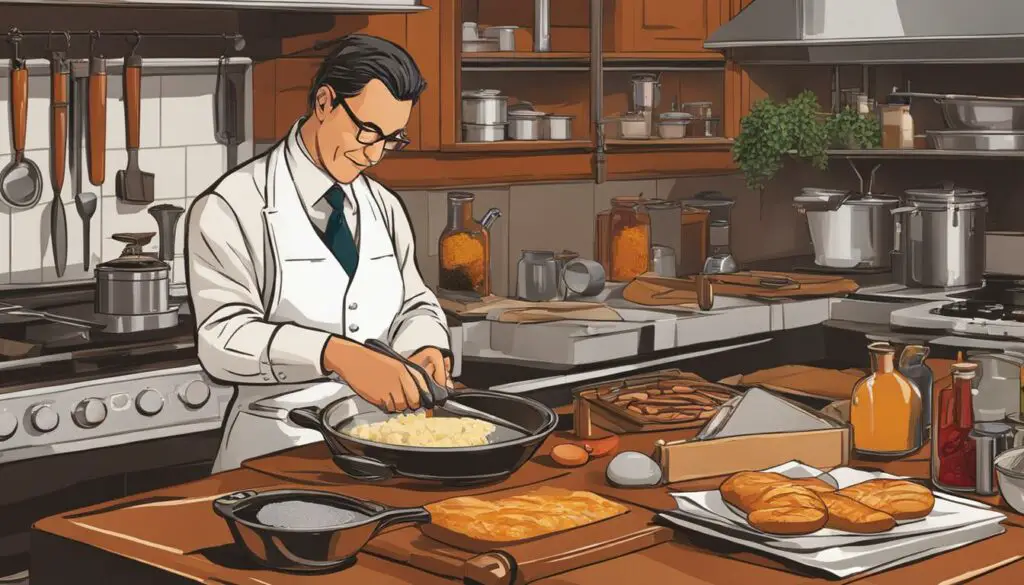
When it comes to patenting a recipe, hiring a patent attorney can be a game-changer. These legal professionals come with specialized knowledge and expertise that can guide you through the complex process of securing a patent for your culinary creation. A patent attorney will assist you in drafting and filing the patent application, ensuring that all the necessary details are included to strengthen your case.
Working with a patent attorney has several advantages:
- Expert Guidance: Patent attorneys are well-versed in intellectual property law and have a deep understanding of the intricacies involved in patent applications. They can provide you with valuable insights and help you navigate through the legal requirements.
- Application Preparation: A patent attorney will help you draft a comprehensive and high-quality patent application. They will ensure that all the essential elements, such as the novelty, usefulness, and non-obviousness of your recipe, are clearly articulated.
- Increased Success Rate: With their experience and knowledge, patent attorneys significantly increase the likelihood of a successful patent application. They know how to handle the complexities of the process and can anticipate potential challenges or objections from the patent office.
- Comprehensive Protection: By working closely with a patent attorney, you can ensure that your intellectual property is adequately protected. They will help you identify and include any additional intellectual property assets associated with your recipe, such as trade secrets or trademarks.
Ultimately, partnering with a patent attorney can provide you with the reassurance that your recipe patent is in capable hands. Their expertise and guidance will streamline the process and give you the best chance of securing exclusive rights to your recipe.
How to Choose the Right Patent Attorney
“Finding the right patent attorney is crucial to the success of your recipe patent application. Look for an attorney who specializes in intellectual property law and has experience working with food-related patents. Ensure they have a strong track record of successful patent applications and positive client reviews. It’s also important to consider their communication style and how well they understand your specific needs and goals.”
Cost of Working with a Patent Attorney
While hiring a patent attorney comes with a cost, their expertise and assistance can be invaluable in the long run. The fees charged by patent attorneys can vary depending on factors such as their experience, location, and the complexity of your recipe patent application. It is advisable to discuss the cost with prospective attorneys during initial consultations to understand their fee structure and how it aligns with your budget.
Remember, the investment you make in hiring a patent attorney is an investment in the protection and commercialization of your recipe. It’s a vital step towards safeguarding your intellectual property and ensuring that you can fully capitalize on its potential.
Conducting a Prior Art Search

Before filing a patent application for your recipe, it is crucial to conduct a thorough prior art search. This search helps determine if your recipe or a similar invention already exists in the prior art, ensuring that your invention meets the criteria for novelty. By leveraging resources such as the USPTO patent database and Google Patents, you can gain valuable insights into existing food products and their patentability.
The prior art search aims to identify any prior inventions or disclosures that could prevent your recipe from being granted a patent. By uncovering existing patents, published applications, scientific articles, and other relevant sources, you can evaluate the novelty and patentability of your recipe. This step is essential to avoid wasting time and resources on an invention that may not meet the necessary requirements.
Once you have conducted a preliminary search, it is highly recommended to engage a professional patent researcher. These experts have in-depth knowledge of patent databases and advanced search techniques, enabling them to perform a comprehensive analysis of the prior art landscape. They can help uncover hidden references and assess the patentability of your recipe more accurately.
In collaboration with a patent researcher, you can refine your patentability search by using keywords and other search parameters specific to your recipe’s unique features. This process ensures that you leave no stone unturned and increases the chances of identifying any potentially relevant prior art.
“A comprehensive prior art search is crucial to assess the novelty of your recipe and determine its patentability. This step helps you understand the existing landscape and fine-tune your invention to meet the necessary criteria.” – Emily Johnson, Patent Attorney
The prior art search plays a vital role in determining the novelty and patentability of your recipe. It helps you evaluate the existing market landscape, identify potential competitors, and assess the uniqueness of your invention. By conducting a thorough search and consulting with a patent researcher, you can make informed decisions on whether to proceed with the patent application process.
| Benefits of Conducting a Prior Art Search | Drawbacks of Neglecting a Prior Art Search |
|---|---|
|
|
Identifying the Rightful Owner
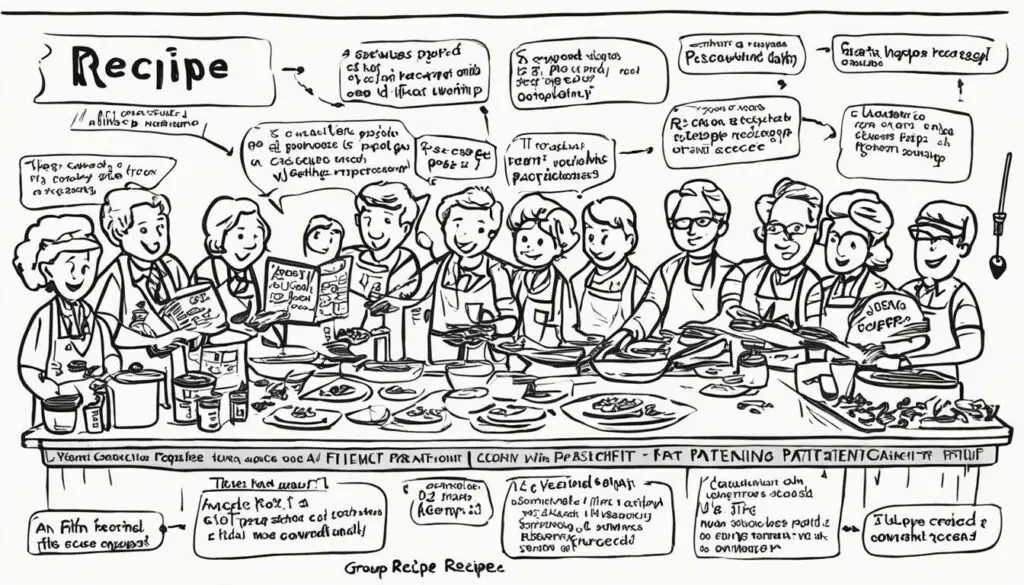
Before proceeding with the patenting process, it is crucial to determine the rightful owner of a recipe invention. This involves thorough documentation and careful consideration of various factors, including:
- Reviewing Records and Documentation: Gather all relevant records and documentation related to the invention. This includes any research notes, sketches, and experiments that demonstrate the development process.
- Identifying Contributors: Determine the individuals who have substantially contributed to the creation and development of the recipe. This may involve assessing the roles of chefs, scientists, or other collaborators who have contributed their expertise in crafting the invention.
- Contractual Agreements: Review any employment agreements or contracts that may govern the ownership of the recipe. It is essential to ensure that no conflicting agreements exist that could impact ownership rights.
- Collaborator Agreements: If the recipe was created collaboratively, consider any agreements or understandings among the collaborators regarding ownership sharing or rights.
Maintaining clear and thorough records of the invention’s development process is crucial in determining ownership and protecting intellectual property rights. By carefully assessing these factors, you can establish a sound legal foundation for patent ownership.
Determining Inventorship for Recipe
| Factors to Consider | Explanation |
|---|---|
| Substantial Contribution | Evaluate the level of contribution made by each individual involved in the recipe invention. This can include key inventive steps, unique techniques, or significant modifications. |
| Collaborative Efforts | Assess the extent of collaboration and joint efforts in the recipe development. Consider the roles and responsibilities of all collaborators and how their contributions interweave. |
| Intellectual Property Rights | Review any agreements, contracts, or employment terms that address intellectual property ownership. Ensure that the ownership rights align with the contributions made. |
| Documentation | Maintain comprehensive records of the invention’s development process, including research notes, sketches, prototypes, and any other evidence that substantiates the individual contributions. |
It is vital to consult with a skilled patent attorney to navigate this process effectively and ensure that the rightful owner or owners are identified. A patent attorney can provide valuable guidance and help in determining the inventorship, minimizing any potential disputes or challenges.
Making a Patent Application

Once the necessary steps are completed, it is time to make a patent application. Filing a patent application for your recipe is a crucial step in protecting your intellectual property and securing exclusive rights. The process of applying for a patent can be complex, but with careful preparation and attention to detail, you can increase the chances of a successful application.
Most patents are submitted using the USPTO (United States Patent and Trademark Office) patent application forms online. It is important to provide accurate details, pay the required fees, and submit any necessary supporting documents. The application forms will require information about the inventor(s), a detailed description of the recipe, and any relevant drawings or diagrams.
Working with a patent attorney can greatly simplify the application process. A patent attorney has the expertise to ensure that all aspects of the application are properly prepared and filed. They can assist in drafting a comprehensive description of your recipe, including all the necessary technical details and claims.
Additionally, a patent attorney can help navigate any legal complexities and ensure that your application meets the requirements set forth by the USPTO. By working with a patent attorney, you can have peace of mind knowing that your application is being handled by a professional with in-depth knowledge of patent law.
Benefits of Working with a Patent Attorney:
- Expert guidance throughout the patent application process
- Assistance in drafting a comprehensive and detailed application
- Ensuring all necessary requirements are met
- Navigating legal complexities and potential obstacles
- Increased chances of a successful application
By entrusting a patent attorney with your recipe patent application, you can focus on your creative endeavors while leaving the legal and technical aspects in capable hands.
Once your patent application is submitted, it will undergo a review process by a patent examiner. It is important to note that the process can take several years before a final determination is made. During this time, it is essential to monitor the progress of your application and respond promptly to any requests or objections from the patent examiner.
Submitting a well-prepared and robust patent application, with the assistance of a patent attorney, increases the likelihood of a successful outcome and ultimately protects your recipe from infringement by others.
| Key Points | Benefits |
|---|---|
| Accurate details | Ensures the correct information is provided to the patent office |
| Required fees | Satisfies the financial obligations for the patent application process |
| Supporting documents | Provides additional evidence and information to support the application |
| Working with a patent attorney | Increases the chances of a successful application and ensures legal compliance |
| Review process | Allows for careful examination of the patent application by a patent examiner |
Notice of Allowance
Once your patent application has undergone review by a patent examiner, you eagerly await the Notice of Allowance from the USPTO, indicating the pending approval of your recipe patent. This formal message signifies a significant milestone in the patenting process and brings you one step closer to securing exclusive rights to your culinary creation.
Upon receiving the Notice of Allowance, you will need to pay the specified fees to the Trademark Office. This payment solidifies your patent approval and ensures that your patented recipe is protected under intellectual property law.
To facilitate the payment process and track the progress of your patent application, the USPTO offers the convenient EFS-Web portal. Through this online platform, you can access updates on your application’s status and address any potential issues that may arise.
Benefits of Notice of Allowance:
- Confirms successful review by a patent examiner
- Signals pending approval for your recipe patent
- Allows you to proceed with securing exclusive rights
- Enables payment of required fees
- Provides access to the EFS-Web portal for tracking your application
Receiving the Notice of Allowance is an exciting moment on your patenting journey. It signifies that your recipe has met the necessary criteria and is one step closer to legal protection and potential commercialization.
Conclusion
In conclusion, patenting a recipe is a multifaceted process that requires careful attention to detail and thorough preparation. From understanding the patent process to conducting market research and building a prototype, each step is essential in ensuring the success of your patent application.
It is crucial to work with a patent attorney who specializes in intellectual property law. Their expertise and guidance will help navigate the complex legal requirements and increase the chances of obtaining a patent for your culinary creation. Additionally, conducting a prior art search and identifying the rightful owner of the recipe are crucial in establishing the novelty and ownership of your invention.
While the cost of patenting a recipe can vary, it is important to budget accordingly and assess the market viability of your invention. By obtaining a patent, you can protect your recipe from being copied or used without your permission, giving you exclusive rights to your creation. The potential financial benefits and competitive advantage that come with a patented recipe make the process well worth the investment.
In summary, patenting a recipe requires careful planning, diligent research, and the assistance of a patent attorney. By following the necessary steps and securing a patent, you can safeguard your culinary invention and potentially establish yourself as a leader in the food industry. Take the necessary steps to protect your intellectual property and take advantage of the opportunities that patenting a recipe can offer.
FAQ
How much does it cost to patent a recipe?
The cost to patent a recipe can vary, but it is typically between $15,000 and $20,000. This includes the cost of drafting the application, government filing fees, and other expenses that may arise during the process.
What are the steps to patent a recipe?
The steps to patent a recipe include building a prototype, researching the current market, hiring a patent attorney, conducting a prior art search, identifying the rightful owner, making a patent application, and waiting for the notice of allowance.
Do I need to build a prototype before patenting a recipe?
It is recommended to build a prototype of the food product before patenting a recipe. This allows you to test and refine the recipe, ensuring it is fully developed before proceeding with the patenting process.
Why is market research important when patenting a recipe?
Market research is important when patenting a recipe to determine the viability of your recipe in the current market. It helps assess the potential profitability of your patented recipe by understanding the competition and demand for similar food products.
Should I hire a patent attorney to patent a recipe?
It is highly recommended to hire a patent attorney when patenting a recipe. They provide specialized knowledge and guidance throughout the complex legal process, ensuring all necessary details are included and increasing the likelihood of a successful application.
Why is a prior art search necessary before patenting a recipe?
A prior art search helps determine if your recipe or a similar invention already exists in the prior art. This search is important to assess the novelty of your recipe and its patentability. It is recommended to conduct a preliminary search and hire a professional patent researcher for a more comprehensive search.
How do I identify the rightful owner of a recipe invention?
To identify the rightful owner of a recipe invention, gather all records and documentation related to the invention, determine the individuals who have substantially contributed to its development, review employment agreements and contracts, and consider agreements among collaborators. Clear and thorough records of the invention’s development process should be maintained.
How do I make a patent application for a recipe?
Most patent applications for recipes are submitted using the USPTO patent application forms online. It is important to provide accurate details, pay the required fees, and submit any necessary supporting documents. Working with a patent attorney ensures that all aspects of the application are properly prepared and filed.
What is a Notice of Allowance?
The Notice of Allowance is a formal message from the USPTO to patent applicants indicating that their application has undergone review by a patent examiner and is pending approval. Once the specified fees are paid, patent protection is granted, securing exclusive rights to the patented recipe.
Any final thoughts on patenting a recipe?
Patenting a recipe involves a complex process that requires careful consideration of the requirements, thorough research, and the assistance of a patent attorney. It is important to budget accordingly and ensure market viability before proceeding. By following the necessary steps and obtaining a patent, you can protect your culinary creation and potentially capitalize on its success.

